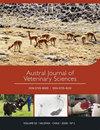鸟分枝杆菌亚型的患病率。哥伦比亚安蒂奥基亚三个地区绵羊群的副结核感染
IF 0.8
4区 农林科学
Q3 VETERINARY SCIENCES
引用次数: 0
摘要
副结核或Johne’s病是一种由鸟分枝杆菌亚种引起的发展缓慢的传染病。副结核病(MAP)主要影响国内反刍动物,并对畜牧生产系统产生重大经济威胁。尽管关于哥伦比亚小型反刍动物副结核病的报道非常罕见,但哥伦比亚绵羊业已将副结核病确定为其发展缓慢的原因之一。有报道称,绵羊群中MAP感染,主要发生在Cundiboyacense高原和波哥大大草原,但哥伦比亚绵羊和山羊群体中MAP感染的流行率尚不清楚。因此,本研究旨在准确估计哥伦比亚安蒂奥基亚省三个地区24只绵羊的MAP感染率。ELISA检测以及培养和直接qPCR作为诊断工具。总体而言,对456份血清样本进行了分析,在24只研究鸡群中的17只(70%IC:51.2-0.90)中发现了至少一只血清阳性动物,总共有37只动物的ELISA结果呈阳性(8%IC:5.5-10.5)。关于MAP直接检测,对24只鸡群的90个粪便池进行了培养并进行了qPCR诊断。直接qPCR和培养分别检测到25个(27.7%)和64个(71.1%)粪池MAP阳性。更具体地说,通过直接qPCR和培养,分别在45.8%(IC:24.3-67.3)和83.3%(IC:67.3-99.3)的鸡群中检测到MAP阳性池。MAP感染在研究地区的绵羊群中广泛存在,为了更准确、准确地检测这种重要病原体的感染,有必要结合几种诊断测试。本文章由计算机程序翻译,如有差异,请以英文原文为准。
Prevalence of Mycobacterium avium subsp. paratuberculosis infection in sheep flocks from three regions of Antioquia, Colombia
Paratuberculosis or Johne’s disease is a slow-developing infectious disease caused by Mycobacterium avium subsp. paratuberculosis (MAP) affecting mainly domestic ruminants and producing a significant economic threat to livestock production systems. Although reports on paratuberculosis in small ruminants in Colombia are very scarce, the Colombian sheep industry has identified paratuberculosis as one of the causes of its low development. There have been reports of MAP infection in sheep flocks, mainly in the Cundiboyacense Plateau and the Bogota savannah, but the prevalence of MAP infection in sheep and goat populations in Colombia is yet unknown. Therefore, the present study aimed to accurately estimate the prevalence of MAP infection at flock level in a sheep population of 24 flocks located in three regions of the province of Antioquia, Colombia. ELISA test as well as culture and direct qPCR were used as diagnostic tools. Overall, 456 blood serum samples were analysed and at least one seropositive animal was found in 17 (70% IC: 51.2-0.90) out of the 24 study flocks and, in total, 37 animals showed positive ELISA results (8% IC: 5.5-10.5). Regarding MAP direct detection, 90 faecal pools from the 24 flocks were cultured and subjected to qPCR diagnosis. Both direct qPCR and culture detected 25 (27.7%) and 64 (71.1%) faecal pools as MAP positive, respectively. More specifically, MAP positive pools were detected in 45.8% (IC: 24.3-67.3) and 83.3% (IC: 67.3-99.3) of the flocks by direct qPCR and culture, respectively. MAP infection is widespread in sheep flocks in the study regions and the combination of several diagnostic tests was necessary to achieve a more accurate and precise infection detection of this important pathogen.
求助全文
通过发布文献求助,成功后即可免费获取论文全文。
去求助
来源期刊

Austral Journal of Veterinary Sciences
Veterinary-General Veterinary
CiteScore
1.60
自引率
0.00%
发文量
18
期刊介绍:
Austral Journal of Veterinary Sciences (formerly Archivos de Medicina Veterinaria) publishes original scientific contributions in English, containing the latest developments and discoveries in veterinary sciences. The journal covers topics such as animal health and production, preventive medicine, zoonosis, pharmacology and therapeutics, methods of diagnosis, and other areas related to the veterinary field.
Austral Journal of Veterinary Sciences aims to divulge information about advances in veterinary medicine among universities, research centres, industries, government agencies, biologists, agronomists and veterinarians.
 求助内容:
求助内容: 应助结果提醒方式:
应助结果提醒方式:


